- Home
- William Styron
Selected Letters of William Styron Page 2
Selected Letters of William Styron Read online
Page 2
There is rollicking humor and deep sadness in these letters; signs of towering ego and profound insecurity; sweet affection and stinging bitterness. You will find elements of all in Bill’s letter to Philip Roth on January 29, 1973. Ostensibly, Bill wrote to comfort Roth after Norman Podhoretz and Irving Howe viciously attacked Roth’s character in an article in Commentary. But before Styron addressed the Commentary piece, he offered a lengthy excursus about his experiences during the Nat Turner controversy and the sheer absurdity of the critical establishment. The nearly 2,000-word letter is a testament to both the isolation and the camaraderie of the modern American novelist. Expressed in classic Styronese, Bill signed off with “Yours in the slime we sometimes find ourselves up to our asses in.”
As one follows the vicissitudes of the writerly existence in these pages, it is hard not to develop a deep attraction to Styron’s mind and pen. My own passion for this correspondence led to a meeting with Bill’s widow, Rose, in the fall of 2007. When Rose asked if I would like to edit Bill’s letters, I naively leapt at the chance. Little did I know that the process of gathering, transcribing, and notating those letters would take the better part of five years, but what an incredible journey it has been. Benefiting from serendipitous circumstances and generous support from various institutions, I was able to meet with Rose daily for almost an entire year. Each morning, we would sit together in the Styron home in Vineyard Haven, Massachusetts, and work through my previous day’s transcriptions and notations. Rose would retrieve names, books, and obscure events at a constant clip. Working intimately with this sparkling soul, the matriarch who knew about or experienced most of what transpires in these pages, has been a distinct privilege.
As this collection grew in size, scope, and quality, Rose and I shared the joy of uncovering a new narrative about William Styron. Quite distinct from a biography or a memoir, these selected letters narrate one writer’s lifelong struggles and joys—captured in private dispatches about professional life, friendship, and family. Indeed, in many ways, the stories in these pages were known only in part to Bill’s individual correspondents, and the extent of this writing has surprised even his closest friends.
Of course, across these pages, certain themes emerge. All the ambitious young littérateurs will be touched by Bill’s self-conscious journey from the Duke classroom to the New York Times bestseller list. Styron’s ambitions are captured in a letter to his mentor William Blackburn in February 1950 as he was finishing his first novel, Lie Down in Darkness. Acknowledging his conscious restraint in the book, Styron expressed his lifelong distaste for “the Hemingway tight-lipped mumble school.” “I believe that a writer should accommodate language to his own peculiar personality,” he continued, “and mine wants to use great words, evocative words, when the situation demands them.”
Styron would spend the next six decades negotiating the tension between the “orotund” and the “spare.” In these intimate snapshots of his interior life, readers will follow the unique circumstances that helped Styron establish himself at the forefront of American letters. These letters are intimate, funny, and profound all at once. One sees his foibles laid bare, his friendships given color and life, and his accomplishments put into sharpest relief. Tracing the deep cultural impact of The Confessions of Nat Turner to the harrowingly personal Darkness Visible, Styron’s letters help us appreciate the swirl of events that contributed to his creative work, and the struggle that took each project from the germ of an idea to a finished product.
Unlike some of his contemporaries, Styron approached letter writing rather haphazardly; he seemed to write only when the epistolary muse struck him. A grudging typist, Styron’s handwritten letters are all unique—that is to say, without carbons. With no eye toward posterity, Styron’s extensive archive at Duke consists almost entirely of letters written to, not by him. As such, the process of assembling this collection has been an ongoing and worldwide search for the scattered but precious words he sent to friends and fans alike. We have been unable, despite Herculean efforts, to track down letters Bill wrote to James Baldwin, for instance, though we know such letters exist. There are surely other gaps and omissions, and so these are William Styron’s Selected Letters, for we fear they could never be made truly complete.
Styron himself spoke to some of these difficulties even in the 1960s. Writing to Blackburn, who was editing the letters of Bill’s Duke classmate, the writer Mac Hyman, Bill mentioned his “surprise” at finding some of their letters in his papers. “During these last years we always spoke to each other by telephone,” Styron explained on March 30, 1965, “the invention which is in the process of killing off all literary correspondence.”
Fortunately, Styron did not cease writing letters altogether, even when the telephone took over more and more of his friendly and professional communication. The hours he would spend on a given day (letters are often clustered in this manner) speak to the psychological space the activity helped create for him in the midst of struggling with a novel. Again and again in these pages, Styron expressed his belief that writing was “a tedious and agonizing process and I loathe [it] with almost a panic hatred.”
But in a letter to Hyman in May of 1953, Styron showed his typical ironic self-awareness as he revealed the importance of writing letters to help navigate that tedium and panic.
All this probably doesn’t interest you in the least, but what it narrows down to is this, if it’ll give you any comfort—that is, if you need any comfort. What I mean is that I think that any writer who ever lived, who was any good at all, has had long long periods of precisely the same sort of strain and struggle that both you and I are going through; I only comfort myself (and God knows it seems like forlorn comfort at times) that it seems to be true that often such periods of doubt and thrashing around eventually produce the best work. They often eventually produce the best work because it is during such periods of struggle (when one is long unpublished or goes through long periods of tortured sterility) that a writer really suffers. A lot of crap has been written about suffering, and the value of it, and in about two seconds I’ll shut up, but every now and then, even in the midst of my most dried-up, sterile depressions, I have a crazy confused moment of joy in the knowledge that anything good I ever did seemed at one time or another impossible of attaining, that it was a hard struggle in getting it out, that it seemed at times to be crushed under the weight of my doubts about it, but if it happened to be good at all it was because of the doubts, and perhaps a little suffering. End of quotation.
It was in his correspondence where Styron not only sounded out his frequent bouts with “melancholy” and “writer’s block” but helped ease himself out of both predicaments. Indeed, Bill’s self-awareness certainly extended to his letters; he wanted them to be more than scrawled grocery lists. He understood them as part of his oeuvre and expressed definite feelings about the publication of writers’ letters. When Blackburn proposed doing a collection of Styron’s letters in 1966, Bill wrote that “the publication of personal letters … has somewhat the quality of gratuitous exposure.” Indeed, responding to a letter he had written to Mac in May of 1957, Styron told Blackburn, “when I read that letter of mine which you sent and thought of it appearing in print, I felt terribly naked all of a sudden.”
Fortunately for those reading this volume, Styron added that “when a writer is dead, certainly that becomes a different matter. Presumably then there evolves enough interest in the writer’s private self that the very publication of his correspondence wipes out the element of gratuitousness … when I myself am dead and someone wants to put my letters together, I couldn’t care less one way or another.”
Although we have taken Styron at his stated indifference, the hallmark of this volume reveals the very opposite guiding emotion. Styron’s care and concern pulse in each word collected here. My hope is that this invitation to see his “private self” will reveal his concern not just for showing love and friendship to those he corresponded with but for ma
king lasting and worthy art for the readers he cared so much about.
R. BLAKESLEE GILPIN
February 2012
EDITORIAL NOTES
AFTER TRANSCRIBING AND ANNOTATING more than one thousand letters, it has been necessary to make certain cuts and edits. Ellipses mark infrequent deletions from the text. We have occasionally included incomplete letters, sometimes missing as much as a page, if the extant contents justified inclusion. Errors in punctuation and spelling have been silently corrected, with the exception of intentionally (often humorously) misspelled words. We have tried to keep explanatory notes to a minimum, identifying the people and books that we have deemed worthy of explanation.
A small number of these letters have appeared in print prior to being collected in this volume. Fourteen of Bill’s letters to the writer Donald Harington appeared in a special issue of The Southern Quarterly in 2002. We have also chosen to reprint several letters that first appeared in Styron’s Letters to My Father, ed. James L. W. West III (Baton Rouge: Louisiana State University Press, 2009). West’s wonderful collection included all of Bill’s letters to William C. Styron, Sr., from January 1943 to October 1953.
All the letters follow a basic format:
Date Written from
RECIPIENT
William Styron dated virtually every letter he wrote during his long life. He also nearly always indicated where he was when he wrote a letter. In this way, readers can track his movements—often alternating seasonally between Roxbury, Connecticut, and Vineyard Haven, Massachusetts—but his extensive travel around the world is also catalogued in these letters. We have dispensed with elaborate abbreviations of archival locations, autograph versus typescript letters, and the like in order to include more of Styron’s actual correspondence. Unfortunately, there is no single location in which to view Styron’s letters. Our efforts to collect material from libraries (The Harry Ransom Center at the University of Texas at Austin and Yale University’s Beinecke Library and Manuscripts and Archives among them) represent a small fraction of the publicly and privately held letters that we solicited, copied, and received in order to represent Styron’s correspondence. In other words, you hold in your hands the closest approximation to an archive of this writer’s letters. Please enjoy them in the spirit in which they were written and received.
WILLIAM STYRON: A TIMELINE
1925 Born William Clark Styron, Jr., on June 11 in Newport News, in the Tidewater region of Virginia.
1932–37 The Styrons move to Hilton Village, a small community just outside Newport News, in 1932.
1939 Pauline dies on July 20, after years of intense pain.
1940 Starts his first year at Christchurch, a small Episcopal boys’ prep school near West Point, Virginia, in September.
1941 Father and Elizabeth Buxton marry and move to Hampton Roads.
1942 Completes year at Davidson College in North Carolina. Transfers to Duke University to join the Marines’ V-12 program and enrolls in Professor William Blackburn’s creative writing course.
1944–45 Ordered to boot camp at Parris Island, South Carolina (sent to the VD ward with a mistaken diagnosis of syphilis). Transferred to Camp Lejeune, North Carolina, for officer training, then sent to Platoon Commander School at Quantico, Virginia, where he is commissioned a second lieutenant.
1946 After the war ends, Styron returns to Duke University. In summer, signs up as a deckhand on the Cedar Rapids Victory, a merchant cattle ship bound for Trieste.
1947 Graduates from Duke and reenlists in the Marine Corps Reserve. Moves to New York City and becomes an assistant editor at Whittlesey House, but is soon fired. Inherits $1000 from his maternal grandmother’s estate, which, combined with his GI benefits, allows him to survive without taking another job. Enrolls in a fiction-writing seminar at the New School for Social Research at the invitation of its instructor, Hiram Haydn. Haydn arranges a $250 advance from Crown for Styron’s first novel.
1948–49 Briefly returns to Durham before moving back to New York City. Stays rent-free with Sigrid de Lima, a friend from the New School, and her mother, Agnes (Aggie) de Lima, then finds a room in the Flatbush section of Brooklyn, where he meets an Auschwitz survivor named Sophie. Faces money problems as GI benefits run out and accepts an offer to live rent-free with Aggie and Sigrid de Lima at their country residence in Valley Cottage, a village near Nyack, New York, north of the city. Father urges Styron to continue working on his first novel and pledges to send $100 a month until its completion.
1950 Hiram Haydn leaves Crown for Bobbs-Merrill in Indianapolis. Styron negotiates a release from his contract with Crown and follows Haydn.
1951 Recalled by the Marine Corps, but Haydn secures him a deferment. Pushes himself physically and emotionally to write the final one hundred pages of Lie Down in Darkness before returning to the service.
Completes an all-night, thirty-three-mile march, and soon afterward is discharged because of a cataract in his right eye.
Lie Down in Darkness published September 10. Invited by Louis D. Rubin, Jr., to meet with graduate students at Johns Hopkins that spring, where he is introduced to Rose Burgunder.
1952 In February, Lie Down in Darkness wins the Prix de Rome of the American Academy of Arts and Letters.
Sails to England on the Île de France for the British publication of Lie Down in Darkness, then on to Paris. Becomes friendly with the American writer Peter Matthiessen, who introduces Styron to his circle of literary expatriates, who will soon found The Paris Review.
In Rome, begins to date Rose Burgunder, writes the manifesto for the first issue of The Paris Review, and proposes marriage to Rose.
1953 Marries Rose Burgunder and honeymoons in Ravello, Italy.
1954 The Styrons move back to New York; Styron spends ten days in bed with heart palpitations. The Styrons purchase a large, two-story nineteenth-century frame house in Roxbury, Connecticut.
1955 Hiram Haydn moves to Random House in January and Styron signs a two-book contract with Random House. Daughter Susanna Margaret born February 25.
1956–58 Norman Mailer and his wife move to nearby Bridgewater, Connecticut.
Daughter Paola (Polly) Clark Styron born March 13, 1958. Mailer accuses Styron of spreading slander about Mailer’s wife, Adele, ending their friendship for twenty-five years.
1959 Hiram Haydn resigns from Random House to start a new firm (Atheneum). Styron decides to work with Bob Loomis at Random House.
Son Thomas Haydn Styron born August 4.
1960 Set This House on Fire published May 5, 1960. The Styrons spend February and March with James and Gloria Jones in Paris, then travel through Geneva, Milan, and Florence, and arrive to settle in Rome in early May.
James Baldwin moves into the Styrons’ guesthouse to work on a novel.
1961 Travels in May to Southampton County, Virginia, with Rose, his father, and a local relative as guide in an attempt to trace the path of slave rebel Nat Turner’s revolt.
1962 Travels to Paris for the publication of Coindreau’s translation of Set This House on Fire.
The Styrons attend a dinner at the White House. Styron transfers the handling of foreign publishing rights, in May, to the London-based Hope Leresche and Steele agency.
Attends William Faulkner’s funeral service in Oxford, Mississippi.
1964 The Styrons decide to purchase a harbor-front house on Martha’s Vineyard.
1965 Viking Press publishes Rose’s first collection of poetry, From Summer to Summer.
1966 Daughter Claire Alexandra (Al) Styron born October 28.
1967 There are prepublication orders of 125,000 copies when The Confessions of Nat Turner is published on October 9.
1968 The Confessions of Nat Turner wins the Pulitzer Prize for fiction.
Flies to Seattle with Arthur Miller and Jules Feiffer to campaign for Eugene McCarthy in the Washington and Oregon Democratic presidential primaries.
Serves as an honorary pallbearer at the funeral of Robert Kennedy.
Beacon Press in Boston issues William Styron’s Nat Turner: Ten Black Writers Respond, a collection of essays attacking the novel.
Attends Democratic National Convention in Chicago.
Travels with Rose to the Soviet Union to attend an Afro-Asian authors’ conference.
1970 Awarded the Howells Medal.
1971 Father, aged eighty-one, marries Eunice Edmundson, aged seventy-six.
1972 In the Clap Shack produced by the Yale Repertory Theatre.
1973 Decides to stop work on Marine novel The Way of the Warrior and begin writing Sophie’s Choice: A Memory after a vivid dream involving Sophie, a Polish Catholic survivor of Auschwitz.
Viking Press publishes Thieves’ Afternoon, a collection of Rose’s poetry.
1974 Styron travels to Europe to visit the death camp at Auschwitz.
1977 James Jones dies of congestive heart failure on May 8, 1977, at age fifty-five.
1978 Stepmother Eunice dies and Styron moves his father to a nursing home near Roxbury where he dies on August 10, 1978.
1979 Sophie’s Choice is published on June 11, Styron’s fifty-fourth birthday, reaching number one on the New York Times bestseller list.
1980 Sophie’s Choice wins the first American Book Award in February 1980.
Styron attends presidential inauguration ceremonies for François Mitterrand in Paris.
1982 Publishes a collection of nonfiction prose entitled This Quiet Dust and Other Writings.

 Selected Letters of William Styron
Selected Letters of William Styron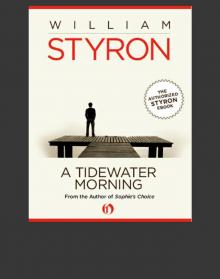 A Tidewater Morning
A Tidewater Morning Sophie's Choice
Sophie's Choice Darkness Visible: A Memoir of Madness
Darkness Visible: A Memoir of Madness My Generation: Collected Nonfiction
My Generation: Collected Nonfiction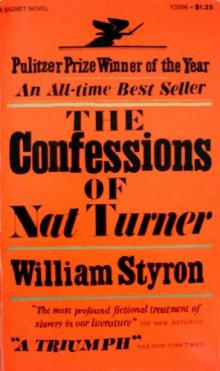 The Confessions of Nat Turner
The Confessions of Nat Turner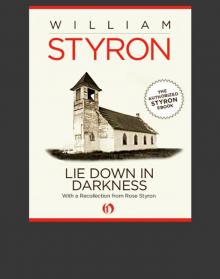 Lie Down in Darkness
Lie Down in Darkness The Suicide Run: Five Tales of the Marine Corps
The Suicide Run: Five Tales of the Marine Corps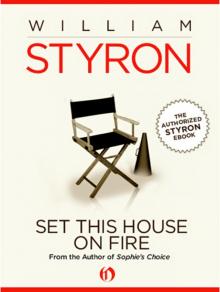 Set This House on Fire
Set This House on Fire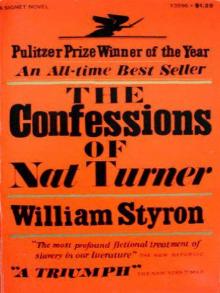 Confessions of Nat Turner
Confessions of Nat Turner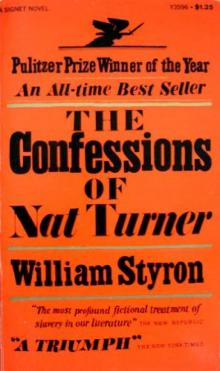 The Confessions of Nat Turner (1968 Pulitzer Prize)
The Confessions of Nat Turner (1968 Pulitzer Prize)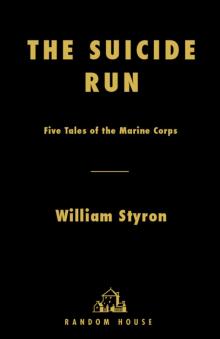 The Suicide Run
The Suicide Run My Generation
My Generation Sophie's Choice (Open Road)
Sophie's Choice (Open Road)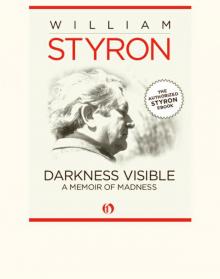 Darkness Visible
Darkness Visible